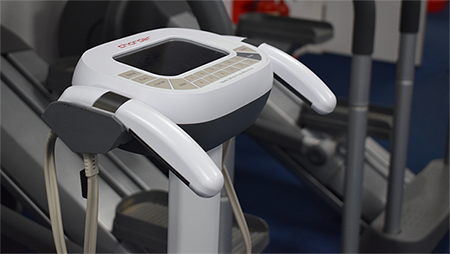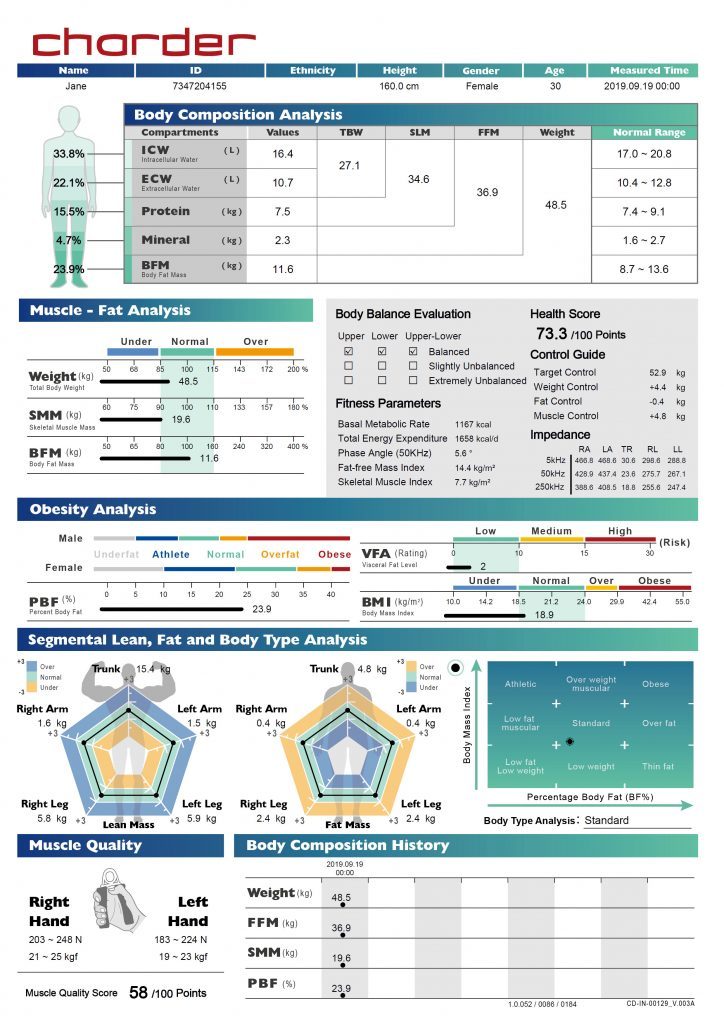7 Reasons Gyms Can Benefit From Our New BIA Scale

Bioelectrical Impedance Analysis, or BIA, is a commonly used method for calculating body composition. It is one of the quickest and most reliable ways to measure body composition.
BIA scales send a safe, small electrical current through the body. As the current passes through your body, it will encounter different types of body tissue, and the contents of these will affect how fast, and how easily, the electric current moves. For example, fatty masses are more resistant than muscle or skeletal mass; it is this resistance that allows a scale to then determine body composition.
You can read more about BIA in this blog post.
What Makes the MA601 Different?
1. Three Frequencies For Segmental Breakdown
By using three frequencies, and hand and feet electrodes, the MA601 can provide detailed segmental fat and muscle analysis of arms, legs and trunk.
However, it’s not just the number of frequencies used that’s important, but also the strength of the algorithms that use the information the frequencies provide.
Charder’s Steven Chen, who worked on the development of the MA601 says: “If a device measures using 5kHz, 50kHz, and 250kHz frequencies - but its algorithms only actually use 50kHz - its results won't be necessarily better, because 5kHz and 250kHz are wasted.
“More frequencies give algorithms more information to work with, but it is the strength of the algorithms that are the key, not the number of frequencies alone.”
Providing a segmental breakdown of body composition enables users to identify specifically where their problem areas are and where they need to focus in the future.
2. No Athlete Setting
Traditionally, BIA devices have been less accurate for ‘abnormal’ populations such as athletes. A commonly-used fix has been to have an ‘athlete mode’, using specialised algorithms. Unfortunately, because there is no clear consensus on how to define ‘athlete’, often users wouldn’t know which mode to select, resulting in inaccurate results when used by ‘non-athletes’.
What’s more, sprinters and weightlifters are both athletes - yet their body types are very different, so an athlete mode that’s based on ‘endurance athletes’ might be less accurate for ‘strength athletes,’ and vice versa.
To improve this, the MA601 uses a ‘universal’ algorithm, to remove the guesswork behind choosing the most suitable category and the possibility of selection error.
3. 41 Measurements in Total
In order to provide an in-depth look at body health, the MA601 results sheet displays 41 body measurements in an easy-to-read, comprehensible way. Ranging from skeletal muscle mass to body fat percentage and even muscle quality, the MA601 is one of only a small number of scales on the market to provide such a complete picture of body health.
The printout below details all of the measurements provided, as well as demonstrates how simple to understand the results sheet is. The complete list of measurements provided is: Intracellular water (ICW), Extracellular Water (ECW), Total Body water (TBW), Protein, Skeletal Lean Mass (SLM), Minerals, Fat Free Mass (FFM), Body Weight, Body Fat Mass (BFM), Skeletal Muscle Mass (SMM), Percentage Body Fat (PBF), Visceral Fat Level (VFA), Body Mass Index (BMI), Segmental Lean Mass (Trunk, Right Arm, Left Arm, Right Leg and Left Leg), Segmental Fat Mass (Trunk, Right Arm, Left Arm, Right Leg and Left Leg), Body Type Analysis, Muscle Quality (Left and Right Hand and Overall Score), Body Balance Evaluation (Upper, Lower and Upper-Lower), Basal Metabolic Rate, Total Energy Expenditure, Phase Angle, Fat-Free Mass Index, Skeletal Muscle Index, Health Score, Impedance and Control Guide (Target Control, Weight Control, Fat Control, Muscle Control).

4. Clear Areas for Improvement
Unlike some printouts provided by competitors, the MA601 provides comparable ranges for results, so that users know whether they are in the ‘healthy’ range and where improvements are needed. Furthermore, the control guide section allows for a quick glance to see where improvement could be made. The segmental analysis can also help users to identify if there are any problem areas, so that they can target those in the future.
The ranges provide for comparison are not static, and take into account factors including gender, age, weight, and height to help place results in context. This means that if two people are of the same weight, but one person is taller than the other, they may be considered ‘underfat’, while the other may be considered ‘normal’. This affects a number of readings, including skeletal muscles mass. Body Fat Mass is based on "normal" body fat percentage standards for respective gender.
The benefit of having the readings come with recommendations, is that the scale will not need to be continuously monitored. This frees up staff members to complete other activities within the gym and can be more comfortable for gym members who feel uncomfortable with other people seeing their fitness results.
5. Store Body Composition History
For users who are eager to see how they develop over time, the scale has the ability to store member data and allow members to access their body composition history. This allows users to compare their new results with their previous results to assess their improvement and cater their training accordingly.
6. Printer Included
We also offer the MA601 with a printer, which is included in the price of the scale. Many competitors do not supply printers with their body composition scales; whereas others offer printers at additional cost.
Having a printer means your clients have instant, tangible results from the scale, which can be a discussion point with their trainer and also provides them with something they can take home.
Set them up with their own profile on the scale too, and over time the Body Composition History section of the results sheet will be populated, to show their progression.
7. Lowest-Priced Scale
Compared to body composition scale industry leaders, the MA601 is significantly more affordable. The MA601 even offers a wider range of measurements than many comparable scales on the market.
Watch the scale in action, below.
Further Reading
In this blog post, we discuss what BIA is and explain how body compositions scales utilise this method to provide accurate results.
Did you know that body composition can be used to increase member retention? We list 5 ways to use body composition to keep members coming back here.
Whether you manage a gym, are a personal trainer, run a slimming group or a fitness class, it’s important to choose the right scale for you.